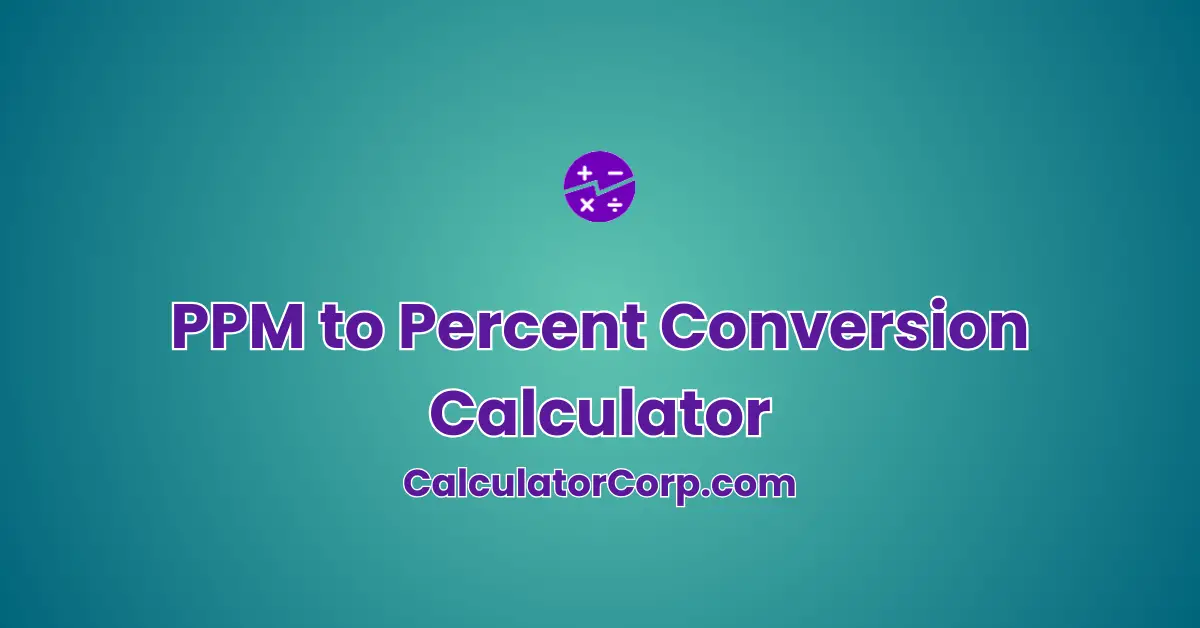The PPM to Percent Conversion Calculator is an essential tool for anyone dealing with scientific, environmental, or industrial measurements. This calculator seamlessly converts values from parts-per-million (PPM) to percent (%), a conversion crucial in various fields, including chemistry, biology, and environmental science.
PPM to Percent Conversion Calculator – Instantly Convert Parts Per Million to Percentage
Our team converts drinks into code — fuel us to build more free tools!
The functionality of this calculator is straightforward yet powerful, offering precision and ease of use to both professionals and enthusiasts.
- Try Percent to PPM Calculator Here
- check out PPB to PPM Conversion Calc here
- use Percentage Decrease Calculator
- try Reverse Percentage Calculator
- check Percent Off Calculator
How to Use the PPM to Percent Conversion Calculator
To use this calculator:
- Enter the value in parts-per-million (PPM) into the provided input field.
- Click the ‘Convert’ button to initiate the conversion.
- The result, in percent (%), will be displayed immediately under the control buttons.
If you need to perform another conversion, use the ‘Reset’ button to clear all inputs and results, allowing for a fresh calculation.
Formula Used in the PPM to Percent Conversion Calculator
The formula for converting PPM to percent is relatively simple:
Percent (%) = (PPM / 10,000)

Here, PPM stands for parts-per-million, which is a unit of concentration. This formula is derived from the fact that one percent is equivalent to 10,000 parts-per-million. It’s a straightforward ratio conversion, where you are essentially dividing the PPM value by the total number of parts per hundred (which is 10,000 PPM).
Step-by-Step Calculation Guide for PPM to Percent Conversion Calculator
Let’s walk through an example:
Suppose you have a solution with a concentration of 500 PPM and you want to convert it to a percent.
- Input the value 500 into the PPM input field.
- Click the ‘Convert’ button.
- The calculator performs the conversion:

The result which PPM to Percent Conversion Calculator displayed is 0.05%.
Definition and Background of PPM to Percent Conversion Calculator
Parts-per-million (PPM) is a unit of measurement used to describe the concentration of one substance in another. It denotes the number of units of one substance per million units of another. This measure is commonly used in science and engineering, particularly in chemistry and environmental studies, to describe small concentrations of pollutants in air, water, body fluids, etc.
Percent, on the other hand, is a more universally known unit that represents a quantity in a fraction of 100. The conversion from PPM to percent is often required in fields that require precise measurements, such as pharmaceuticals, environmental monitoring, and chemical manufacturing.
Understanding this conversion is crucial for ensuring accuracy in scientific research, industrial processes, and environmental regulations. It enables professionals and researchers to communicate and compare concentrations in a universally understood format.
Table of Example Calculations for PPM to Percent
Here are some examples of real-life scenarios where converting PPM to percent is essential:
| Scenario | PPM Value | Percent (%) |
|---|---|---|
| Air pollution measurement | 250 PPM | 0.025% |
| Ingredient concentration in a product | 1,000 PPM | 0.1% |
| Trace chemicals in water | 75 PPM | 0.0075% |
For instance, in air pollution measurement, a reading of 250 PPM of a particular pollutant means that for every million parts of air, there are 250 parts of the pollutant, which is equivalent to 0.025%.
Glossary for PPM to Percent Conversion
- PPM (Parts-per-Million): A unit of measurement for concentration, indicating the number of parts of a substance per million parts of the whole.
- Percent (%): A unit of proportion in a fraction of 100.
- Concentration: The abundance of a constituent divided by the total volume of a mixture.
- Conversion Formula: Mathematical formula used to change a value from one unit to another.
PPM to Percent Conversion Calculator FAQ Section
Q1: What does PPM mean? A1: PPM stands for parts-per-million, a unit of concentration indicating the number of parts of a substance per million parts of the whole.
Q2: Why convert PPM to percent? A2: Converting PPM to percent is necessary for simplifying data presentation and making it easier to understand for broader applications.
Q3: Is the conversion from PPM to percent accurate? A3: Yes, the conversion is based on a simple and accurate mathematical formula.
Q4: Can I convert percent back to PPM? A4: Yes, by multiplying the percent value by 10,000.
Q5: Is this calculator suitable for all types of PPM to percent conversions? A5: Yes, this calculator is versatile and can be used for any scenario where PPM to percent conversion is needed.
Additional Reading Resources about PPM to Percent Conversion Calculator
Here are some online resources that provide information and tools for PPM to Percent Conversion, including definitions, background, examples, and calculators:
- miniWebtool – PPM to Percent Converter: This website offers a simple tool for converting PPM to percent. It explains what PPM is and provides the conversion formula.
Visit miniWebtool - RapidTables – PPM Conversion: RapidTables offers a comprehensive guide on PPM conversion, including how to convert PPM to percent and vice versa. The site also provides formulas for converting PPM to other units like ppb, and milligrams/liter.
Visit RapidTables - PercentCalc – Convert ppm to percent and vice versa: This website provides a straightforward formula for converting PPM to percent and percent to PPM. It also explains the concept of PPM in chemistry and the relationship between PPM and percentage by weight.
Visit PercentCalc - InspectAPedia – Convert Between Percent & PPM: InspectAPedia offers detailed explanations and examples for converting between percent and PPM concentrations in liquids or gases. It also includes a conversion table and formula.
Visit InspectAPedia
These resources cover the basics of PPM and percent, provide examples of conversions, and include online tools and calculators for quick conversions.



